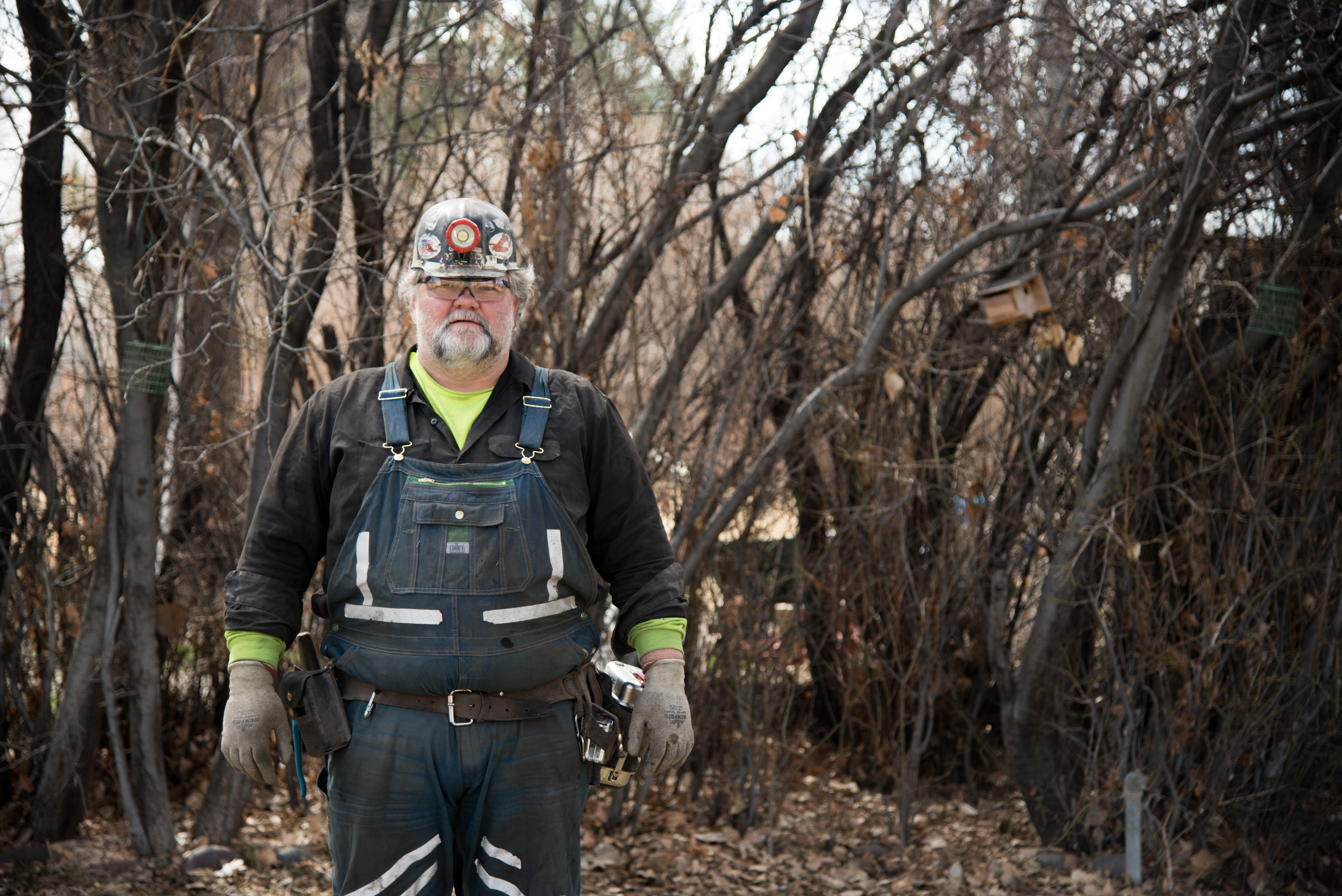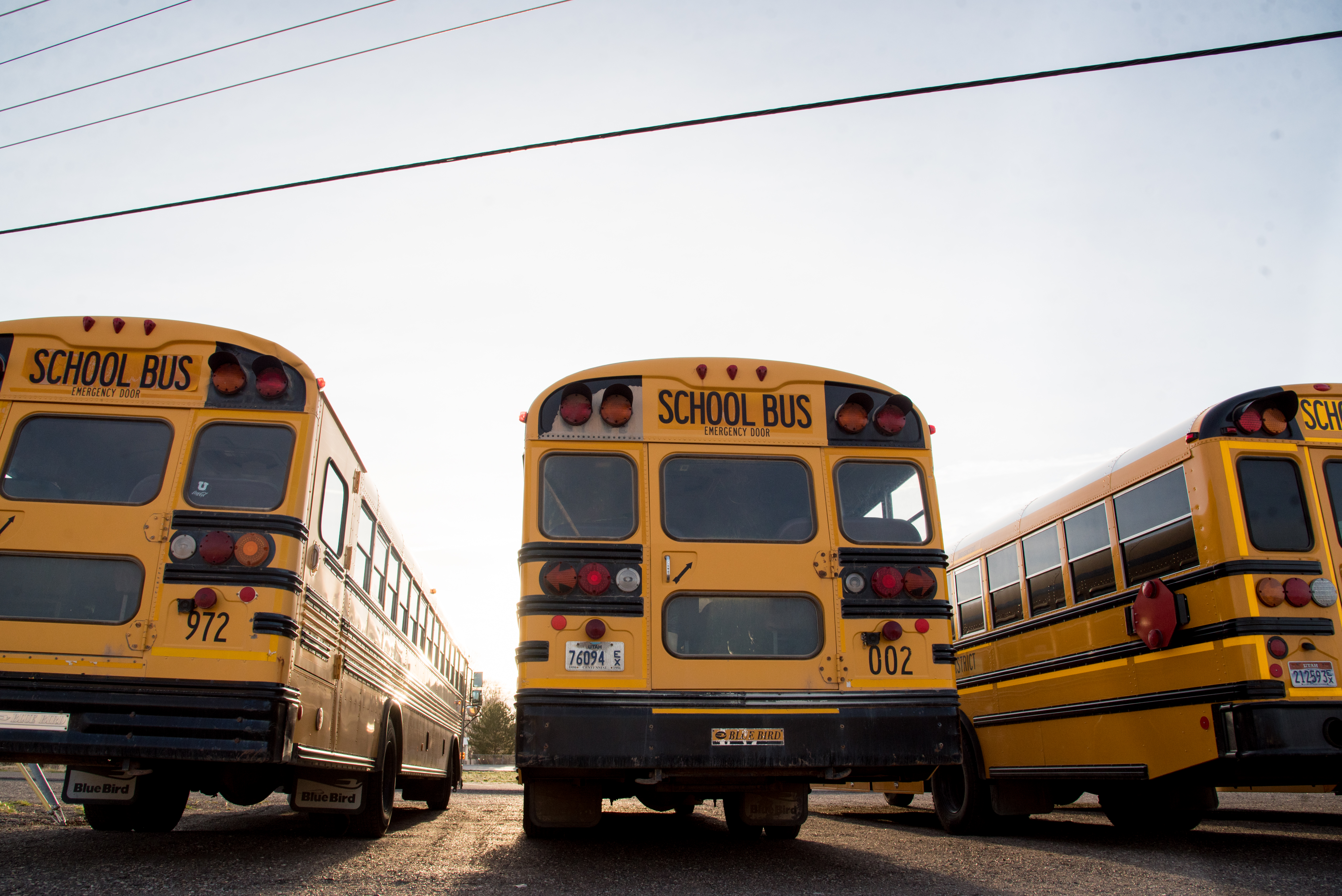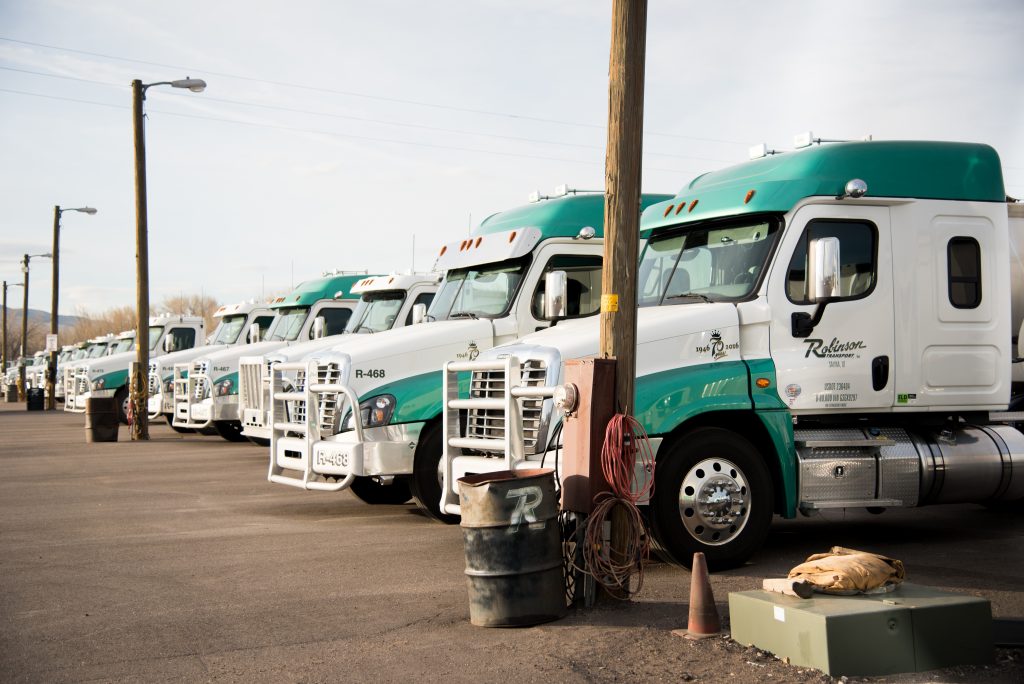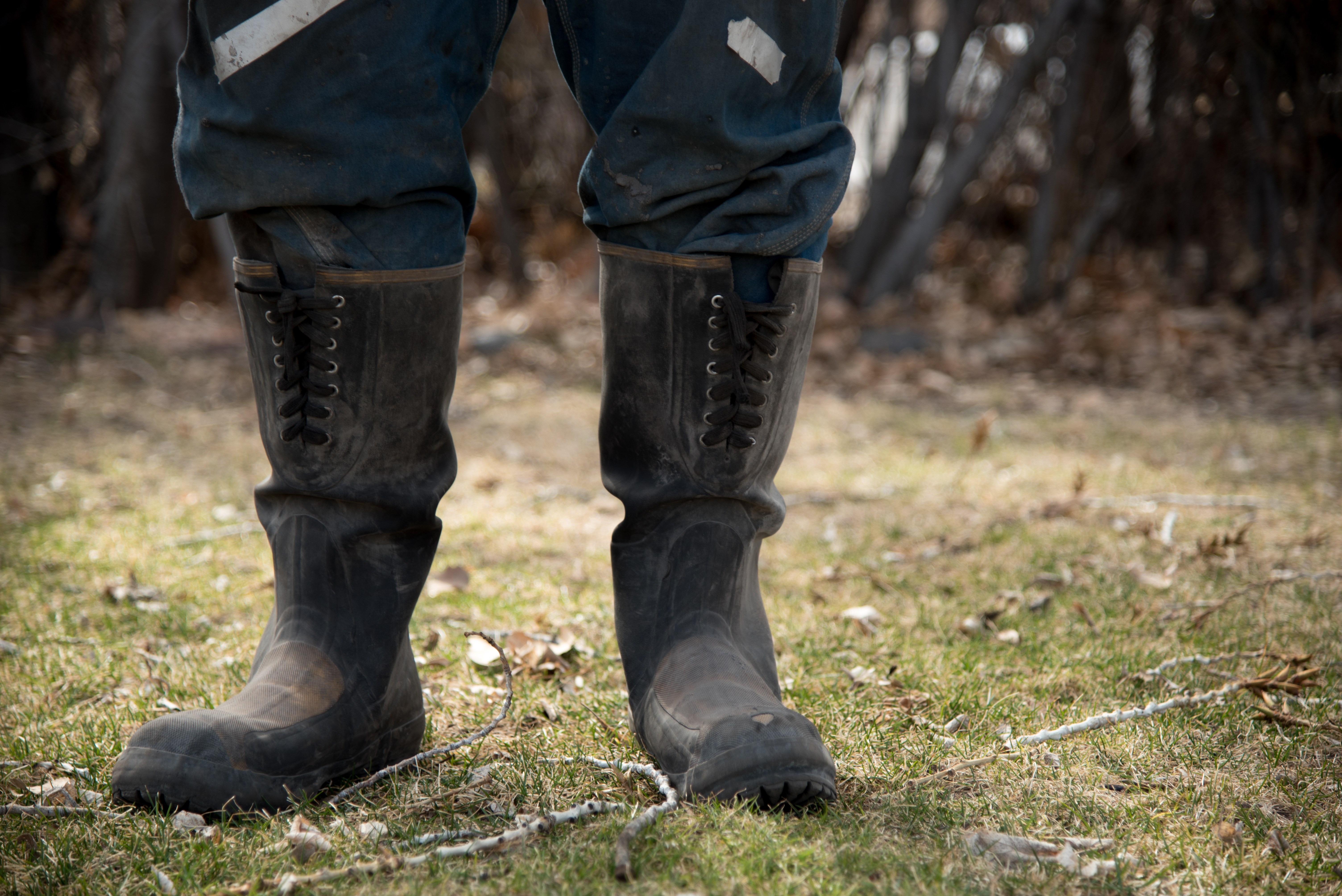Powered by Coal
Ribbons of headlights weave between fields and farmland from all over the valley every morning before the sun rises. Coal miners commuting to work meet to board buses that transport them to the mine. For the small rural towns in Sevier County, this mundane practice is as vital to the mining economy as it is for veins carrying blood to the heart.

Miners drive to the Sufco office in Salina to catch buses that transport them up the canyon to the mine. (Photo Kelsie Matheson)
The Sufco mine, formerly known as Southern Utah Canyon Fuel Company, is currently owned by Bowie Resource Partners and supports a large majority of Sevier and Sanpete counties. Sufco is the longest continuously-operated mine in Utah and has supported small towns like Salina, Aurora, and Redmond in Sevier County since 1941. But pressures for the country to move toward renewable energy by politicians and activist groups could change the coal market drastically in the coming years. Natural disasters could also cause the mine to close down permanently. And because coal is a limited natural resource, Sevier County needs to create a more diverse economy in order to create a job force if the mine ever does close.

Salina, the town closest to the mine, has vacant buildings that are a glimpse into what the future could hold for the community if the economy doesn’t become more diverse. (Photo Kelsie Matheson)
“There will be a lot of people hurting if the mine closes,” said miner Michael Johnson who started working at the mine in 2006 to support his daughter. Originally he didn’t plan on making a lifetime career out of it, but now he can’t see himself working anywhere but the mine.
Johnson has since married and made a home in Redmond. He and his expectant wife, Jordan, will soon be a family of six. The coal mine has provided them a comfortable lifestyle in a community they enjoy.
“If something happened to the mine I would try to find another mine to work at close by; that way I could commute and I wouldn’t have to move my family. If not, we would have to leave,” Johnson said. He has training in construction and welding but the pay and benefits that the mine offers are significantly better than other occupations in the area. Like many people in the community, his livelihood is dependent on the success and future of the coal mine.
Utah’s landscape is speckled with small mining towns like the ones that surround Sufco. Miners moved their families into rural areas for work; schools, convenience stores, and hospitals followed to support the growing populations. But when mines struggle, people leave. Now many of these rural hamlets are on the verge of becoming ghost towns. If Sevier County doesn’t take steps now to expand its economic base, residents there could face the same fate.
Sufco has a projected lifespan of 15 to 20 years. There are additional coal reserves in the area, according to Sufco mine general manager John Byars, but the mine only focuses on a 10- to 20-year lifespan, careful not to overshoot the market for what was once known as “black gold.”
Even if the coal reserves are there, many factors could prevent it from being mined. Corporate owners have to take into account the cost-to-profit ratio, the safety of employees, and their ability to obtain leases to mine certain areas.

For miners like foreman Jason Peterson, who has been at the mine for 29 years, the changing projections of the coal mine are expected. However, younger miners are a little more apprehensive about the industry’s prospects for job security.

On the inside of every miner’s belt is an engraved metal tag with their name and assigned number. In case of a fatal accident, rescue crews would be able to identify the miners. Each miner also carries a self-rescuer respirator, electronic tracking devices and the tools they need to bring the coal out of the mine. (Photo Kelsie Matheson)
Peterson thinks politicians opposed to fossil fuels are a large reason that younger miners are nervous about the future. “Coal mining is a dying breed because of all the coal mines that have closed due to the lack of support from the government,” Peterson said.
As electric utilities have moved away from coal to renewable energy, the lagging demand for coal has hit some of the largest coal companies in the United States. Arch Coal and Alpha Natural Resources both declared bankruptcy during President Obama’s years in the White House, but are now fighting to make their way back.
Policies on climate change during the 2016 presidential election played a large part in how this rural community voted. “I was terrified,” Jordan Peterson said. “Obama had already done quite a lot of damage to the coal miners and coal mining and if Hillary (Clinton) had come in, I feel it would have been the final nail in the coffin for this kind of job.”

Utah’s most economic coalfields are located across Sevier, Emery, and Carbon Counties. These coalfields form an inverted “U” shape according to Utah Department of Natural Resources.
President Trump signed the Executive Order on Energy Independence in March 2017 to review the Clean Power Plan and to repeal the 2016 federal moratorium on coal. The president’s signature is a push to make the country both pro-energy and pro-environment, former EPA Administrator Scott Pruitt stated in a news release following the event.
Sevier County Commissioner Ken May said coal is “absolutely necessary until we find something to replace it that makes sense for everyone.” According to May, the move from coal to renewable energy should be based on economics, not special interest groups.
Coal is a limited natural resource. If Sufco can withstand political and social pressures, there will come a time when coal in the area will run out. “It isn’t a matter of if, but when,” May said.
As the Sufco mine general manager for 23 years, May is pushing to help diversify the economy in Sevier County now as a county commissioner. “The county needs to be prepared to have a tax base and an economic base for employment. If not, the communities will end up with a huge deficit by 2030 to 2040,” May said.
Coal Community to Ghost Town
From Coal to Ashes
Some mining communities that once flourished are now ghost towns. Kenilworth, Utah, part of Carbon County, is in the midst of becoming a ghost town with a population of 180 people. The town took root around coal mining in the early 1900s, and by 1947 had a population of 1,050. But when the mine’s production fell, people started leaving and by 1983, the old mining operation was demolished.
When the coal market began to plummet in Colorado, mines began to cut their numbers and some even had to close their doors. Foreman Brian Gibson moved his family from Colorado to Utah to take up employment at the Sufco mine after multiple attempts to stay in Colorado.
“We tried to stay in the area as long as possible. We sold our home, boat, trailer, as much as we could to keep our family in Colorado where my kids have friends and we have family,” Gibson said.
Coal production in Colorado has dropped over 50 percent since 2004, starting with the first voter-led Renewable Energy Standard in the nation according to colorado.gov. By doing this, Colorado “required electric utilities to obtain a percentage of their power from renewable energy sources.” That percentage has increased three times since 2004, making Colorado a leader in renewable energy but also causing many of their citizens to leave the state after losing employment.
In 2003, Colorado had 2,118 coal mining jobs. By January 2018, that number had dropped to 1,106 based on Colorado Division of Reclamation, Mining and Safety data. Many people tried to make do with work they could find in the area, but most had to leave to find other employment. Nothing compared to the pay, benefits, and lifestyle that coal mining offered Gibson and his family.
“If the coal mine shuts down families are going to move. When we lose families, doctors lose patients, teachers lose students. Slowly and systematically, everything is going to shut down,” Jordan Peterson said.
Jordan works at the local middle school as a student aid. She loves her career and she loves the fact that their children have friends in the rural town. “It is a great place to raise kids and I would hate to leave,” she said. “We really hope that people can bring positive attention to coal mines to keep them going.”








Sufco employs nearly 450 people, 25 of which are contracted. According to May, five people receive a paycheck for every coal miner as a result of the mining economy. These paychecks are unrelated to the mine directly, meaning the mine provides upwards of 2,000 jobs for Sevier County. This number does not include the 300-plus truck drivers that are needed to haul the coal.
Even within the community itself, the demand for coal has changed. At one time every home in the area was heated by coal. Nelson Sunbeam Coal was the main distributor and would deliver coal to area homes regularly during the year. Nelson’s also delivered coal to the local turkey plant, schools, churches and even to surrounding counties and states.
“The change of our environment and our people has produced a ‘play-weekend’ mentality. People want to go out on the weekend and not care for their coal furnace,” said Kirby Nelson, owner of Nelson Sunbeam Coal. The old coal-fired furnaces are now few and far between, even in rural mining communities.

Sunbeam Coal used to deliver coal to nearly every home in the area. The shift from coal furnaces has forced the company to evolve. (Photo Kelsie Matheson)
Sunbeam Coal has considered shutting down its deliveries, but the owners say they owe it to the community to give back even though there are days they might not have any customers.
Even though business isn’t as good as it once was for Sunbeam Coal, the coal business has been very good to the Nelson family. “It has allowed me to venture off into other areas and diversify,” Nelson said.
Like most people in the community, Nelson fears that if anything were to happen to the coal mine the town would go full circle. “We were built on agriculture and might end up back there,” Nelson said.

The Need to Diversify
When Superintendent Cade Douglas of the Sevier County School District started his teaching career in the area, he drove truck for Robinson’s Transport, hauling coal during the weekends and summer break for four years.
During his first year, Douglas asked his fourth-grade students to raise their hands in class if one or both of their parents worked for the mine or trucking businesses and 21 of the 27 said yes. “If the mine were to suddenly go away, there would have been only six kids to teach,” Douglas said. “The classroom ratio for the school district that we staff at is about 1 to 25.”
Douglas has been trying to help diversify the area by working with community leaders, business leaders and chamber of commerce to welcome new businesses.
“The mine for many years was the top tax revenue provider for the school district and although it hasn’t been for the last few years, it still pumps a lot of money into our schools,” Douglas said.
Douglas said expanding the economic base is a double-edged sword in many residents’ minds. He said the communities are afraid of growth because they want to stay small and rural. But without a larger variety of businesses, local economies will crumble. “We want good family growth. People who are good, have strong morals, are hardworking, and have good careers in place so that we are growing our economy in a good way,” Douglas said.

(Graphic created by Kelsie Matheson)
The 2018 Economic Report to the Governor compiled by the University of Utah David Eccles School of Business and the Governor’s Office of Management and Budget said Utah leads the nation in job growth, up 3.1 percent. The future of Sevier County could greatly benefit if new businesses moved into the area to provide variety to the labor force.
Despite the economic realities in rural central Utah, there are residents who will fight change. “We don’t need to be huge, we just need a small percentage of growth so that we can all thrive,” he said, “Even if that means losing some of our farmland, that’s ok. We have to make some decisions to embrace, accept and encourage growth instead of pushing it away all the time.”

Large trucking companies are utilized by the mine to haul coal. Sevier County is a prime location for transporting goods to various parts of the country. (Photo Kelsie Matheson)
There are a lot of systems in place to encourage business growth in Sevier County. With several large trucking companies, two high traffic interstates, and the Richfield Municipal Airport that has plans to expand the runway, the infrastructure is in place to get goods and services in and out of the area.

Rep. Carl R. Albrecht (Utah House of Representatives)
“If we can diversify instead of sending our best export out, we can build and grow and have good families stay here. We are exporting our most valuable resource – our kids. But there are no jobs here for them to have that opportunity to stay,” Douglas said.
State Rep. Carl Albrecht R-Utah sponsored the rural jobs bill, HB390, which provides incentives to companies that create jobs in targeted areas of rural Utah. The bill is in line with Gov. Gary Herbert’s rural job initiative to build 25,000 jobs throughout rural Utah by 2022.
“Utah is number one in business growth because people want a well-educated workforce and low electricity rate, which leads to reduced operating costs,” said Jacob Smith, engineer manager at Sufco. He attributes the low electrical costs to coal.
Based on the U.S. Energy Information Administration (EIA) report, 2,503 megawatt hours (MWh) of Utah’s net electrical energy generation was produced by coal-fired power plants at the end of 2017. That number nearly tripled the MWhs produced by petroleum-fired, natural gas-fired, hydroelectric-fired, and non-hydroelectric renewables combined.

Jacob Smith believes Utah’s positive job growth goes hand in hand with Utah’s low electricity rates thanks to the state’s coal production. The U.S. Energy Information Administration (EIA) shows that most of Utah’s electricity is from coal-fired plants.
According to Smith, Sevier County is a prime location for manufacturing businesses because it is halfway between Denver and Los Angeles, making the area a logical shipping hub. Salt Lake City, Phoenix and Las Vegas, are all easily accessible because of the interstate systems located within the county.

In 2016, coal and natural gas produce over 90 percent of Utah’s net electricity. Coal alone produced 95 percent of Utah’s net electricity in 2005 but has declined to 69 percent in 2016 according to U.S. Energy Information Administration. (Photo Kelsie Matheson)
Smith also suggested that by improving the area’s internet speed, more companies could move in. “There would also be more opportunities to work from home for the people who belong to the tech companies moving in up north,” he said.
After the birth of his first child, Smith knew he wanted a different lifestyle for his family. When an opening at the Sufco mine became available, Smith moved his family from Parker, Colorado, where he worked for an engineering firm. The mine gave them the opportunity to have the quality of life his family was looking for.
Smith estimates that 80 to 90 percent of the miners at Sufco live in Sevier County. The coal mine is one of the highest paying employers in the area, but with a questionable future for miners, new employment options would
“draw more potential employees to work,” where housing is more affordable and the lifestyle is enviable, Smith explained.

The coal market has changed significantly since the mine began in 1941, but it is still a significant part of the economy. (Photo Kelsie Matheson)
Growing up in northern Utah, Smith didn’t realize that people still mined coal. With a push to improve Sevier County’s economy, he’d like to see some pride in what already exists. “Our Achilles heel is that we haven’t done a very good job of educating people on the benefits of coal,” Smith said. He wants to see the industry educate Americans about the positive impact of coal.
Every morning Johnson joins hundreds of coal miners who retrieve the precious black rock that helps power homes and businesses across the state, the country and various parts of the world. He kisses his wife goodbye, checks on his sleeping children, and tries not to fret too much about what the future of mining might hold for them. His occupation is teetering amid the political winds, activist groups and Mother Nature every day.
“I hope there is something that can come in to create jobs if something happened,” Jordan said, “But I don’t think there is anything that can replace the coal mine, not when it comes to the mass jobs that go with it, but I hope I am wrong.”

*Editor’s Note: photos were not allowed within the mine.
